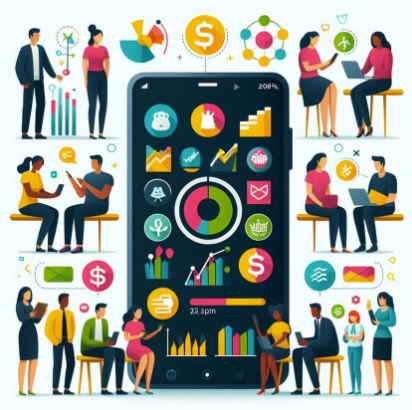Money management is a scary job and even for people who do not know anything about investments. However, the financial world is evolving rapidly by adopting fintech applications (i.e., fun and educational tools) for understanding finance. A successful route is the gamification, converting complex financial ideas into interactive, games-like structures. In this article, we’ll explore how gamifying your finances through app-based learning can transform your understanding of investments. We'll also discuss the opportunities, potential risks, and key apps to consider.
Why Gamify Financial Learning?
- Increased Engagement: Gamification (which increases user engagement through the use of challenges, reward, and competition). A 2022 Deloitte investigation showed that gamified mobile apps result in a 30% (increased retention of information) increase in user engagement in the same year. Instead of the traditional passive way of information absorption, users actively engage in their financial literacy process, making the process fun and memorable.
- Lower Barriers to Entry: Complex financial terms can deter beginners. The gamification of apps results in the foraminal openings by serializing concepts in miniature, units of information (lessons). For example, platforms such as Zogo and Invstr offer quizzes and fun activities for learning details, from stocks and bonds to portfolio management, in a maximum of one hour per day.
- Real-Time Learning with Immediate Feedback: Many apps are available that offer rich and interactive simulation of financial markets in which users can ethically practice−and learn from−strategy for investing. Apps like Stockpile and Stash offer virtual trading brokers that, by the time they are finished, automatically feedback the user what they have just done. The "hands on" approach of this technique provides a confidence that is also prepared to cope with some similar tasks found in real world investing.

How Gamified Investment Apps Work?
- Micro-Lessons and Quizzes: Playing applications are frequently deployed as micro-lessons--extremely brief task (less than 5 minutes) that can be solved in a few min. Each lesson is then assigned a quiz or challenge to assess your learning. For example, Zogo rewards participants with cash and gift cards after they have finished financial literacy modules.
- Virtual Portfolios: There exist apps which offer the so called virtual portfolio that allows a user trades without actual money. For instance, Invstr deducts $1 MN of phantom money to construct a portfolio under simulation, thereby learning the dynamics of the market in what is called a risk-free environment.
- Rewards and Leaderboards: Gamification thrives on incentives. Users earn badges, points, or even real-world rewards. Leaderboards foster an element of competition that drives users to learn more about finance in order to rise to the top ranks. In a platform for such an approach to incentivize children and young adults to learn about investing, Acorns Early, learning is made algorithmically adaptive to both the user's skill level and to the user's experience/progress.
Top Gamified Finance Apps
- Zogo
- Primary Feature: Financial literacy quizzes
- Target Audience: Beginners
- Unique Selling Point: Rewards users with gift cards for completing modules
- Invstr
- Primary Feature: Virtual trading and portfolio management
- Target Audience: Intermediate users
- Unique Selling Point: Offers $1 million virtual cash to practice investing
- Wealthbase
- Primary Feature: Stock market games
- Target Audience: Competitive learners
- Unique Selling Point: Social features and friendly competitions
- Stash
- Primary Feature: Guided investing with real money
- Target Audience: Beginners transitioning to real investments
- Unique Selling Point: Combines learning with real investments, starting at $1

The Benefits of Gamifying Financial Learning
- Better Knowledge Retention: Gamified learning enhances memory retention. According to eLearning Industry, interactive learning has a retention of as high as 90% while standard methods are typical of 30% of conventional environments. The more engaged learners are in instruction, the better it is at remembering and the better it is at making use of what learners have learned.
- Confidence Building: Participants are able to enter real-world investment decisions using practice after going through a risk-free environment. For instance, confidence in investing their own funds rose by 25% when users in virtual trading applications traded virtual money, according to a 2021 study by Schwab.
- Accessibility for All Ages: Gamified applications target a wide audience so that educational programs in the field of finance are available for users aged 20 to 50 years. Whether you’re a young adult learning to budget or a professional exploring investment option, there’s an app designed for you.
Potential Risks of Gamified Finance Apps
- Overconfidence: Gamified environments can create a false sense of security. Virtual success doesn’t always translate to real-world success. Investors are recommended to adopt a conservative stand, and it should be remembered that volatility will ultimately result in varying returns.
- Data Privacy Concerns: Like all digital platforms, data privacy is an issue. Be sure that the app you download has robust security features (e.g., two-step verification and data encryption).
- Addiction to Rewards: The reward system in gamified apps can be addictive. Users and so on may give too much value to the reward when it comes about the finance arguments, and then they may make the wrong investment decisions.
Best Practices for Using Gamified Finance Apps
- Set Clear Goals: Determine what you want to learn or achieve. Whatever the application, when used for budgeting, savings, or investing, setting an intelligent goal can help keep one on track.
- Limit Time Spent: Allocate a specific time each day for learning. This helps prevent burnout and ensures consistent progress.
- Review Real-World Applications: The study should follow a model in which a concept is learned within a gamified environment and the application in real environments is then investigated. This bridges the gap between theory and practice.

Future Outlook
Gamification of money could be the greatest to revolutionize money management and investing. Financial literacy can be attained in a fun and exciting way based on the fun and exciting applications. On the other hand, as much as possible, virtual learning on the internet should be supported by experience. Using the right method, these applications are the new agents of change from which you may accomplish your monetary goals.





